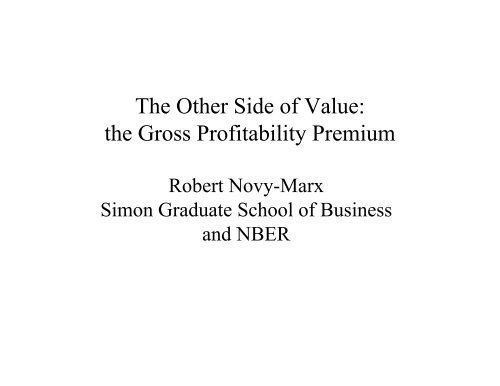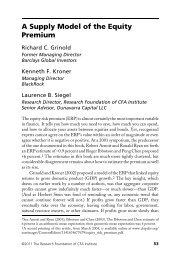The Other Side of Value: the Gross Profitability Premium - Q Group
The Other Side of Value: the Gross Profitability Premium - Q Group
The Other Side of Value: the Gross Profitability Premium - Q Group
Create successful ePaper yourself
Turn your PDF publications into a flip-book with our unique Google optimized e-Paper software.
<strong>The</strong> <strong>O<strong>the</strong>r</strong> <strong>Side</strong> <strong>of</strong> <strong>Value</strong>:<br />
<strong>the</strong> <strong>Gross</strong> Pr<strong>of</strong>itability <strong>Premium</strong><br />
Robert Novy-Marx<br />
Simon Graduate School <strong>of</strong> Business<br />
and NBER
Main results<br />
• <strong>Gross</strong> pr<strong>of</strong>itability is a powerful predictor<br />
<strong>of</strong> <strong>the</strong> cross-section <strong>of</strong> average returns<br />
– MMuchhstronger than h earnings i or free f cashflows hfl<br />
• HHas about b t as much h power as B/M<br />
– And is complimentary to book-to-market<br />
• GP/A negatively correlated with B/M<br />
• Helps distinguish “good growth” from ordinary growth
Implications<br />
• Obvious implications for portfolio construction<br />
• Challenge to popular <strong>the</strong>ories <strong>of</strong> value<br />
– PPr<strong>of</strong>itable fit bl firms: fi<br />
• Less distressed (FF 1993)<br />
• Longer durations (LW 2007)<br />
• Lower levels <strong>of</strong> operating leverage (CFG 2004)<br />
• Provide a unifying feature <strong>of</strong> most earningsrelated<br />
anomalies<br />
– AAnd dmany seemingly i l unrelated l t danomalies li
Why should pr<strong>of</strong>itability matter?<br />
• Berk (1995): High IRR� IRR� low valuations<br />
– So low values associated with high returns<br />
– Conditional on valuations, valuations pr<strong>of</strong>itable �� high IRR<br />
� Pr<strong>of</strong>itability premium<br />
• LSV (1994): mispricing � value premium<br />
– Sort on B/M partly sorts on <strong>the</strong> mis-valuations<br />
– Conditional on valuations, pr<strong>of</strong>itable underpriced<br />
� Pr<strong>of</strong>itability premium
Dividend discount model with<br />
clean surplus accounting<br />
• Fama-French (2006)<br />
• Ceteris paribus:<br />
– ↑ M �� ↓ r<br />
– ↑ Y � ↑ r<br />
– ↑ dB �� ↓ r
• Why hold all else equal?<br />
– Recursive formulation:<br />
– S iis economic i pr<strong>of</strong>its fi (“surplus”) (“ l ”)<br />
– X is expensed investment (e.g., R&D, advertising)
• Can also write as<br />
– Here N is rents to investment (“net gain”)
Why gross pr<strong>of</strong>itability?<br />
• <strong>Gross</strong> pr<strong>of</strong>its are “cleanest” cleanest measure <strong>of</strong> true<br />
economic pr<strong>of</strong>itability<br />
• Earnings “punished” for growth growth-related related activities<br />
– Costumer acquisition<br />
• Ad Advertising, ti i commissions i i<br />
–R&D<br />
– DDevelopment l t<strong>of</strong> forganizational i ti lcapital it l<br />
• Free cashflows fur<strong>the</strong>r “punished” for CAPX<br />
– Even optimal investment
Prima facie evidence<br />
• Pr<strong>of</strong>itability predicts economic growth, growth<br />
even after controlling for valuations<br />
– AAno<strong>the</strong>r h di dimension i <strong>of</strong> f“ “growth” h”<br />
• <strong>Gross</strong> pr<strong>of</strong>its-to-assets predicts:<br />
– <strong>Gross</strong> pr<strong>of</strong>it growth<br />
– Earnings g ggrowth<br />
– Free cashflow growth<br />
– Dividends and repurchases<br />
• Note: earnings and cashflows go <strong>the</strong> o<strong>the</strong>r way
Pr<strong>of</strong>itability and Pr<strong>of</strong>itability Growth
Pr<strong>of</strong>itability and Earnings Growth
So is pr<strong>of</strong>itability relevant for AP?<br />
• Two stories why it might be<br />
– But <strong>the</strong>y don’t actually provide <strong>the</strong> answer<br />
• Ultimately an empirical question<br />
• Emphatic “yes” in <strong>the</strong> data<br />
– More pr<strong>of</strong>itable firms significantly outperform less<br />
pr<strong>of</strong>itable firms
Portfolio sorts<br />
• If GP/A really predicts returns, returns should see it in<br />
simple trading strategies (and you do!)<br />
• Also show clear positive correlation between<br />
pr<strong>of</strong>itability and current valuation ratios<br />
– Thi This fact f t leads l d to t FF (1993) di discussion i th that t HML<br />
may reflect earnings-related risk<br />
– AAnd dwhy h GP/A GP/Ai isn’t ’tobvious b i iin <strong>the</strong> th data d t<br />
• But sort on GP/A, growth outperforms value
Insurance<br />
• For your value strategy<br />
– Levering to run pr<strong>of</strong>itability over value reduces<br />
return volatility!<br />
• <strong>The</strong> best kind insurance<br />
– It pays you<br />
• Negative average “premiums”<br />
• MMomentum t orthogonal th l tto joint j i tvalue l<br />
pr<strong>of</strong>itability strategy<br />
– HHas di diversifying, if i but b not hedging, h d i role<br />
l
“High” High Frequency Strategy<br />
Bigger spreads using better information<br />
• Rebalance monthly<br />
– EEnd d<strong>of</strong> fmonth th<br />
• Using most recent accounting data<br />
– Released quarterly<br />
• From 1972
“High High Frequency Frequency” Strategy
• 26% correlated with PEAD<br />
– Also some momentum<br />
• But significant information ratio relative to <strong>the</strong>se<br />
• And to low frequency pr<strong>of</strong>itability strategy<br />
• Highly persistent pr<strong>of</strong>its<br />
– So “cleaner” cleaner to analyze low frequency strategy<br />
• No PEAD, No momentum<br />
• Relation to value more clear
<strong>Value</strong>-pr<strong>of</strong>itability <strong>Value</strong> pr<strong>of</strong>itability relation<br />
• <strong>Gross</strong> pr<strong>of</strong>its-to-assets and book-to-market<br />
negatively correlated<br />
• Univariate sort on GP/A sorts against B/M<br />
– Similarly, sorting on B/M sorts against GP/A<br />
•Suggests that:<br />
– Pr<strong>of</strong>itability strategies should perform better when<br />
constructed to control for valuations<br />
– <strong>Value</strong> strategies should perform better when<br />
constructed d to control l for f pr<strong>of</strong>itability<br />
fi bili
HML “decomposition”<br />
decomposition<br />
• Book-to-market sort used in HML sorts against<br />
pr<strong>of</strong>its-to-assets<br />
– So HML is long “real” real value value, but short<br />
pr<strong>of</strong>itability<br />
• I.e., short “good good growth” growth<br />
• Investigate by constructing:<br />
– HML that controls for GP/A<br />
– HML-like GP/A “factor” that controls for B/M
Effect is strong in large caps<br />
• Double sort on size and pr<strong>of</strong>itability<br />
• Pr<strong>of</strong>itability spread is smaller in large caps<br />
– Th Though h still till significant i ifi t<br />
• FF3 alpha almost undiminished in large caps<br />
– Sorting on GP/A still sorts against B/M<br />
• Especially among bigger stocks
Simple large cap pr<strong>of</strong>itability/value strategy<br />
• Each June select 500 largest non-financial firms<br />
• Rank on GP/A and B/M<br />
– BBuy ttop 150 by b rank-sum k<br />
– Sell bottom 150 by rank-sum<br />
• Large spreads (almost 8% per year)<br />
– Huge capacity<br />
– Low trading costs<br />
• Liquid stocks<br />
• Turns over only once every three years
• 7.5% per year in <strong>the</strong> biggest, most liquid stocks<br />
– Twice <strong>the</strong> spread <strong>of</strong> <strong>the</strong> similarly constructed value and<br />
pr<strong>of</strong>itability strategies
• Long side<br />
Portfolios (End ( 2010) )<br />
– Top: Astrazeneca, GlaxoSmithKline, JC Penney, Sears and<br />
Nokia<br />
– Bi Big: WlM WalMart, tJh Johnson &Jh & Johnson, AT&TItlV AT&T, Intel, Verizon, i<br />
Kraft, Home Depot, CVS, Eli Lilly and Target<br />
• Short side<br />
– Bottom: Ivanhoe Mines, Ultra Petroleum, Vertex<br />
Pharmaceuticals, Marriott International, Delta Airlines,<br />
Lockheed Martin and Unilever<br />
– Big: Apple, IBM, Philip Morris, McDonald’s,<br />
Schlumberger Schlumberger, Disney, Disney United Technologies, Technologies Qualcomm, Qualcomm<br />
Amazon and Boeing
“Explaining” Explaining anomalies<br />
• Power<strong>of</strong>grosspr<strong>of</strong>its-to-assets Power <strong>of</strong> gross pr<strong>of</strong>its-to-assets suggests it<br />
might “explain” anomalies<br />
– A proximate proximate, not ultimate explanation<br />
• Anomalies might be taking positions in pr<strong>of</strong>itability<br />
• Like LRR strategies are a backdoor to size and value<br />
– Doesn’t explain why pr<strong>of</strong>itable firms outperform in <strong>the</strong> first place<br />
– Simple Fama-French Time-Series regressions to<br />
identify <strong>the</strong>ses positions<br />
• Pr<strong>of</strong>itability factor<br />
• Industry adjustments to HML and UMD
• Roughly 2/3 <strong>of</strong> improved pricing comes from <strong>the</strong> pr<strong>of</strong>itability<br />
factor<br />
• <strong>O<strong>the</strong>r</strong> 1/3 from industry adjusting HML and UMD
Conclusions<br />
• <strong>Gross</strong> pr<strong>of</strong>itability is a powerful predictor <strong>of</strong> <strong>the</strong><br />
cross-section <strong>of</strong> average returns<br />
– Obscured by its negative correlation with B/M<br />
• Sort on B/M, looks like pr<strong>of</strong>itable stocks underperform<br />
• Presents an additional challenge to rational<br />
value stories<br />
• “E “Explains” l i ” <strong>the</strong> th abnormal b l performance f <strong>of</strong> f many<br />
seemingly unrelated strategies<br />
– Many anomalies take positions in pr<strong>of</strong>itability



